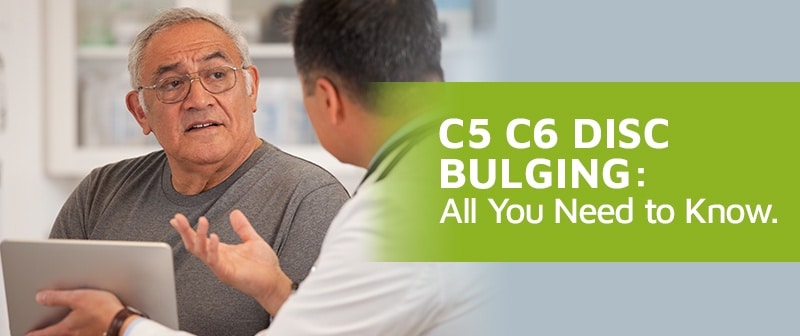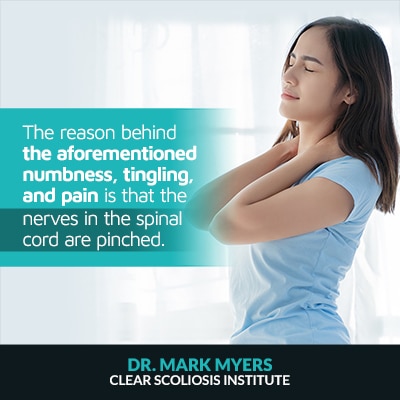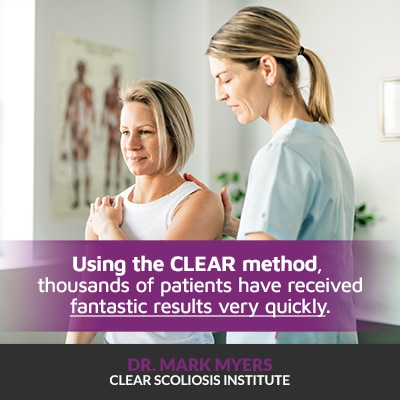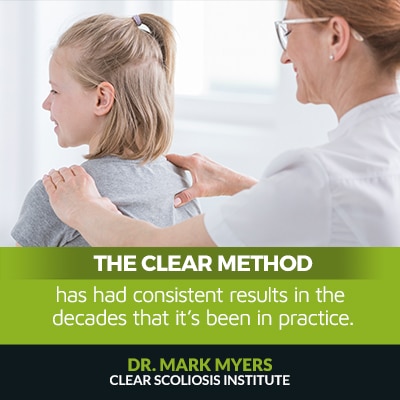
The spinal cord serves as the communication point of the body’s central nervous system by carrying signals from the brain to the peripheral nerves. When disc problems such as C5 C6 disc bulging occur in the cervical spine, it can create pressure on the nerve roots next to the spinal cord, which can lead to a variety of symptoms and health concerns.
If you have recently been diagnosed with a C5 C6 bulging disc, you may find yourself asking questions such as:
Throughout this blog, we’ll explore the answers to all of these questions and more.
Let’s first discuss the difference between a bulging disc and a herniated disc. Although the words are often used interchangeably, they are actually different. A protruding disc is considered herniated when a rupture or tear is present. When no rupture or tear is present in a protruding disc, it is considered a bulging disc.
A slipped disc and ruptured disc are both other names for a herniated disc.
The diagnosis of a C5 C6 bulging disc often includes a physical exam and imaging tests. While a physical exam is important and frequently includes neurological testing, the only way to be sure you have a bulging disc is through diagnostic image testing via magnetic resonance imaging (MRI), and computed tomography (CT).
Patients with bulging and herniated discs may experience similar symptoms; however, not everyone experiences symptoms or pain. A C5 C6 bulging disc may lead to:

When forward head posture is present, it places abnormal stress on the discs. Significant forward head posture can lead to C5 C6 disc bulging.
Pain associated with C5 C6 disc bulging can be experienced as a result of disc pain or nerve root pain. Nerve root pain and the associated symptoms are known as radiculopathy. According to Johns Hopkins Medicine, “Cervical radiculopathy describes a compressed nerve root in the neck (cervical spine). Because the nerve roots in this area of the spine primarily control sensations in your arms and hands, this is where the symptoms are most likely to occur.”
In the proper position, the cervical spine has a natural curve at the top. When the neck becomes straight, doctors can often see immediate changes in the surrounding nerves. This can often lead to the numbness and tingling associated with C5 C6 disc bulging.
Patients diagnosed with adolescent idiopathic scoliosis (AIS) may experience pain. Occasionally, this pain may be associated with a bulging or herniated disc. In fact, in a study of 152 patients with painful AIS, 32 had a herniated nucleus pulposus (inner core of the vertebral disc). This means that 21% of patients with painful AIS also had a herniated disc.

Traditional medical treatment is one of the first approaches that patients opt for when they notice an issue or are experiencing pain from a bulging disc. Medical treatment may include:
Because a bulging disc can cause inflammation, doctors will often prescribe some sort of medication. Patients with severe symptoms can experience near constant pain. Medications such as steroids can temporarily reduce inflammation, therefore minimizing the pain patients experience.
Physical therapy can also be used to treat the symptoms of a bulging disc, but it can be painful and uncomfortable. Massage, heat, ultrasound or electric stimulation can be used by a PT to relieve pain.
As a last resort, doctors may recommend spinal fusion. This type of surgery fuses two or more discs of the spinal cord together. It can help to reduce the pain and physical alterations of the problem, but it will partially limit the patient for life. This type of surgery can have many types of complications such as infections, nerve damage, or even death.
Patients often try to avoid surgery due to the aforementioned limitations, combined with the natural fear of surgical procedures and the high costs. The main goal is to prevent surgery and try a few other methods to correct the spine and prevent it from getting any worse.

At CLEAR, our goal is to correct the biomechanics of the entire spine as much as possible, improving everything from the top down, instead of looking at only one specific area. By doing this, patients receive more favorable results.
Because of our approach, the CLEAR method is highly sought after by patients looking for an alternative nonsurgical approach to treating scoliosis.
Prior to beginning treatment at a CLEAR Scoliosis Center, patients may receive a digital motion X-ray. This process allows the scoliosis specialist to see how the cervical spine moves from all angles.
Each patient’s case is different and their recommended treatment will be unique to their individual case. During a typical visit at a CLEAR Scoliosis Center, patients can expect to spend 90 to 120 minutes in the clinic. In-office treatment includes three different phases known in CLEAR Scoliosis Centers as mix, fix, set.
Another huge benefit that patients will experience with the CLEAR method is that they can do a significant portion of the treatment at home. A CLEAR-certified doctor will prescribe home care exercises that are designed to be painless, which is not always the case with traditional physical therapy or other remedies. Rather than three office visits a week, patients are able to do their prescribed home care in the comfort of their own home.
To determine whether scoliosis is progressing, re-examinations must occur. Re-exams are often done one to two times per year. A re-exam for scoliosis patients often includes X-rays to monitor results, recommendations and treatments, and corrections.
Patients who utilize the CLEAR approach experience consistent results. The following expectations show how reliable and influential the CLEAR approach can be:

Whether you’re dealing with C5 and C6 discs bulging from scoliosis, poor posture, or another cause, it is best to get evaluated by a trained expert, such as a CLEAR-certified chiropractor. Modern medical procedures are costly and often cause permanent side effects. The CLEAR method produces consistent results with little to no side effects.
If the C5 and C6 discs are bulging, they only cause pain about 50 percent of the time, but this condition can lead to a straightened neck; this leads to tension on the spine, known to cause numbness, pain, and tingling throughout the upper body.
While steroids and physical therapy can reduce inflammation, they’re not always able to get to treat the underlying cause of the problem. Here at CLEAR, our patients have been benefiting from our approach since it was first established in 2000.
If you suspect any kind of disc issue, our CLEAR-certified doctors have the training, experience, and knowledge to treat the condition in a non-invasive and effective way, allowing each and every patient to continue living their best life.
Disclaimer: The author’s views are his or her own and may not reflect the views of CLEAR Scoliosis Institute.

CLEAR provides a unique and innovative way of understanding scoliosis. Sign up to receive facts and information you won’t find anywhere else.

Ive had degenerative c5 and c6 discs for over 36 years. What can i do to help the pain and discomfort? And if it means surgery what are the complications and also the success rate?
Hello, Michael,
Thank you for reaching out. Our CLEAR Scoliosis Institute Doctors are trained in helping patients restore the normal curvatures of their spine as much as possible without the use of surgery. They have specialized equipment in their office in order to help with this process. They are also trained in providing customized exercises per patient based on your individual needs and imaging. I would suggest contacting the CLEAR Scoliosis Institute certified clinic nearest to you. To find the closest clinic, please visit our website and click on Find a Doctor.
Regarding surgical complications and success rate, you would have to speak with the orthopedic surgeon you have been referred to, as our doctors do not perform the surgery. Best of luck. Please let us know if we can be of further assistance.
Hi Dr. Myers. My name is Juan Jose Gonzalez. I live in Zephyrhills Florida I am 53 years old men. And in August 1st 2019 I got into a car accident which end up with a (MRI). So the doctor told me that I need a surgery a discectomy on my cervical between C3 and C4 with a plate infusion which I got it done. So after this I didn't have no problem with my back only a little bit of pain on my lumbar between L4 and L5 with a bulging disc. So a second (MRI) that he sent to performed and that he look at it was okay and I can go back to work. But then I continue with the pain so I call him back and he decides to perform a (MBB),(RFA) which I decide to do on July 28th and August 14th. But then I couldn't get it done because a slip and fall and and now I'm having problems with my back from the neck middle back and lumbar. But now I went to chiropractor and he send me to get an (MRI)he them look at them and he asked me if got a lawyer and I said yes. So he told me let me show you this because when I got to his office I could barely walk or move. Them he continues to tell me that I got a bulging and herniate disc between L4 and L5 and the disc is desiccated to and asked him what should I do them. So he told me them you should go and see a neurosurgery and remove the disc and look at the rest of the problem. And then that same day the lawyer call me and said he dropped the case because I slipped bud I didn't fall. So went and hire another lawyer so I explained to him and took my case and send me to see another chiropractor. Now this other chiropractor told me did I have to get therapy to get an evaluation but I told him I already know what I got and I need to see a Neurosurgery. And he told me that we was going to get an (MRI) from the cervical and the middle of the back. The second accident was on 7/16/2021. But now I got wait for those results and see what other damage I got and I'm in a lot of pain right now.
Now those results from 7/16/2021 from my lumbar I get them and read them.
IMPRESSION:
1. Bulging disc at L3-4 eccentric to the left with left-sided L3-4 foraminal narrowing.
2. Desiccated bulging disc at L4-5 with a central and left-sided disc herniation and left-sided L4-5 foraminal narrowing.
3.Facet joint hypertrophy from L1-2 to L5-S1 bilaterally.
4.Bilaterally renal cysts.
I'm sorry for my writing but I'm not good on computers but I try my best. I will be in touch with you as soon as I get all the other results and I forgot to tell you that they found STENOSIS L4-5.
If you want to call me my number #(813-770-0483)
THANK YOU
Dear Sir,
I am suffering with Cervical Spondylitis, and the MRI Report mentioned the below points:
1. Reversal of Cervical lordosis is seen.
2. Degenerative changes are seen in the form of marginal osteophytes, end plate changes and cervical disc desiccation.
3. Mild reduction in vertebral body height is seen involving C4 and C5 vertebral body.
4. Diffuse disc bulge is seen at C3-C4 with left paracentral disc protrusion indenting on anterior thecal sac mildly compromising left recess.
Diffuse disc bulge is seen at C4-C5 level indenting on anterior thecal sac without any significant neural compromise.
5. The cervical vertebrae show normal alignment and marrow slightly intensity.
6. Posterior disc bulge is seen at L5-S1 level with annular tear indenting thecal sac.
7. Early degenerative changes in lumbar spine with posterior disc bulge at L5-S1 level with annular tear indenting thecal sac.
So please look into this matter and kindly suggest me sir. I feel very pain at neck and spinal cord, also suffering with vomiting sensation, weakness and Numbness.
Regards,
Venkat Raghavan
Hello, Venkat.
The reversal of cervical lordosis means that you have lost the natural curvature of your neck and it is curving the opposite direction than it should. This will cause an acceleration of degenerative changes, including disc bulges/changes, osteophytes, etc. The best place to start would be to seek out a provider/chiropractor who specializes in restoring the natural curvature of the neck in order to slow down the degenerative processes that have already begun. The lumbar spine or low back has the same natural curvature as the neck and will cause the same type of degenerative changes when you begin to lose that curvature. Again, restoring the natural curvature of the neck will help slow down the degenerative process. Our CLEAR Scoliosis Institute certified Doctors are well trained in the treatment of curve restoration. They have specialized equipment in their offices that help to address this exact problem. They also will provide you with a customized at-home treatment regimen to help with restoration and stabilization. To find the nearest CLEAR certified doctor, please visit our website under Find a Doctor and this will help guide you where best to look. Please contact us if you have further questions. Best of luck.
MRI of Cervical spine (IN 1.5T)
Cervical spine straightened. Multilevel anterior and posterior marginal osteophytes noted. Disc dehydration noted a multiple levels. Cervical cord reveals normal intensity.
C4-C5: Central and left para central disc protrusion is seen indenting the thecal sac without foraminal narrowing or nerve root impingement.
C5-C6: Central and left para central disc protrusion is seen indenting the thecal sac causing bilateral foraminal narrowing without overt nerve root impingement.
Both ALL & PLL are intact.
Ligamentum flavum is not hypertrophied. Facet joints are normal.
No abnormal prevertebral or paravertebral soft tissue mass is noted
kindly advise
Hello, Biswajit,
The straightening of the cervical spine means that you have lost the lordosis or natural curvature of your neck. This will cause an acceleration of degenerative changes including disc bulges/changes, osteophytes, etc. The best place to start would be to seek out a provider/chiropractor who specializes in restoring the natural curvature of the neck in order to slow down the degenerative processes that have already begun. Our CLEAR Scoliosis Institute certified Doctors are well trained in the treatment of curve restoration. They have specialized equipment in their offices that help to address this exact problem. They also will provide you with a customized at home treatment regimen to help with restoration and stabilization. To find the nearest CLEAR certified doctor, please visit our website under Find a Doctor and this will help guide you where best to look. Please contact us if you have further questions. Best of luck.
c5-c6 4mm posterior central protrusion and annular tear causing mild central canal stenosis. no neural foraminal stenosis
c6-c7 3mm posterior central protrusion and annular tear causing mild central canal stenosis. no neural foraminal stenosis
c7-T1 2mm posterior central protrusion and annular tear causing mild central canal stenosis. no neural foraminal stenosis
need your suggestions .
Typically these protrusions are either caused by or are an aggravating factor of a reversal or straightening of the curvature of the cervical spine. Oftentimes we can see the protrusions and symptoms of them alleviated by restoring the neck curvature. Our CLEAR Scoliosis Institute certified Doctors specialize in restoration of the curvatures of the spine. They have specialized equipment in their offices in order to achieve this, as well as prescribing and providing equipment and customized exercises for a patient to perform at home. I would suggest contacting the CLEAR Scoliosis Center nearest you to determine if you would be a candidate for the type of care they provide. To find the nearest center, please visit our website under Find a Doctor. Best of luck to you.
Hi Dr. Myers. I am suffering with Cervical Spine.
Below MY MRI Report: Kindly Advise any Exercise or treatment.
Technique: MRI of the cervical spine was performed without contrast using routine protocols.
Findings:
There is straightening of cervical sagittal lordosis, likely secondary to muscular spasm. Partial loss of
disc hydration signals are identified from C2-C3 through C5-C6 levels. There is a high intensity zone
within right lateral fibers of C5-C6 disc, suggestive of an annular tear, which may produce pain.
Craniometric measurements are within normal limits. Vertebral marrow demonstrates normal signals.
Cervical cord demonstrates normal signals throughout its length. There is no evidence of tonsillar
herniation, syrinx or demyelination.
C2-C3: There is no significant disc bulge. Patent spinal canal and neural foramina.
C3-C4: There is no significant disc bulge. Patent spinal canal and neural foramina.
C4-C5: There is no significant disc bulge. Patent spinal canal and neural foramina.
C5-C6: There is 2.1 mm broad based disc bulge with right paracentral 4.9 mm disc osteophyte complex
indenting the anterior thecal wall causing mild spinal canal stenosis at the right paracentral region with
mild compression over right traversing nerve roots within the dural canal. Bilateral neural foramina are
patent.
C6-C7: There is no significant disc bulge. Patent spinal canal and neural foramina.
C7-T1: There is no significant disc bulge. Patent spinal canal and neural foramina.
Impression:
Straightening of cervical sagittal lordosis, likely secondary to muscular spasm.
Annular tear within right lateral fibers of C5-C6 disc, which may produce pain.
At C5-C6 level, mild spinal canal stenosis at the right paracentral region with mild compression over right
traversing nerve roots within the dural canal due to broad based disc bulge and right paracentral disc
osteophyte complex
Hello, Hameed,
Thank you for reaching out. It is common for a loss of cervical lordosis to result in disc herniation/degeneration, as well as soft tissue instability. In order to address these issues, the first step would be to begin to restore the cervical lordosis. Our CLEAR Scoliosis Institute Doctors have specialized equipment in their offices to restore cervical lordosis. I suggest contacting the CLEAR Scoliosis Center nearest to you for treatment. To find the nearest Doctor, please visit our website under Find a Doctor. Best of luck. Please let me know if we can be of further assistance.